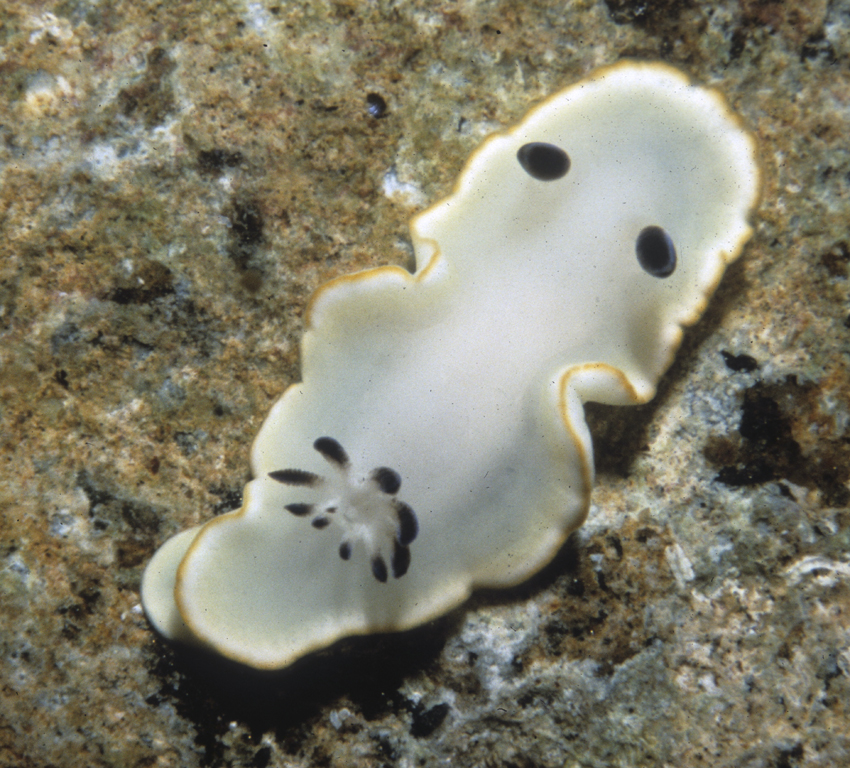 |
Ardeadoris scottjohnsoni
Photo courtesy of Scott Johnson
Puako, Hawaii, May 1978
Ardeadoris scottjohnsoni Bertsch & Gosliner, 1989
The last BOW I wrote was about Boat-Named Slugs. One could describe this contribution as “Bird-Named Slugs”! Dr. Bill Rudman (1984) named the genus Ardeadoris “from the Latin 'ardea', the heron, a reference to Heron Is, Great Barrier Reef, where the type species is commonly found” (p. 163). He named the species egretta, which is the genus of the Reef Heron Egretta sacra. Terry Gosliner and I named the second species of Ardeadoris “in honor of our good friend and colleague Mr. Scott Johnson in recognition of his many contributions to our understanding of the taxonomy and biology of Indo-Pacific nudibranchs” (quotes from B & G, 1989, unless otherwise credited). He has befriended birds since Hawai'i and has recently been befriended by a heron at his home on Kwajalein.
Living animals of Ardeadoris scottjohnsoni are 15–25 mm long; there is a “prominent wavy crenulation about midway down the length of the body. The 10 simply pinnate gills are white basally, with the distal two-thirds black. The animal vibrates the gills (which are usually held partly upright, slightly spread). The rhinophores are black with a thin vertical white line on the anterior face.
“The dorsum and sides of the foot are pure white ; both regions are encircled by an even whiter marginal band. Surrounding the white notal band is a thin yellow orange stripe at the edge of the overhanging margin” (p. 263).
“The radular formula of the single specimen examined was 42 x 15.1.1.1.15. There is a faint trace of a rachidian row of teeth (Figures 32, 33). The inner lateral teeth (Figures 32, 33) are elongate and sickle-shaped, with 5–8 rounded denticles on the inner margin of the teeth. The succeeding lateral teeth are curved, elongate, with 3–6 palmately divided denticles on their distal tip (Figure 34).”
The reproductive system is triaulic. “The narrow preampullary duct expands into a short, saccate ampulla. The ampulla narrows distally, and bifurcates into the short oviduct and vas deferens. The vas deferens is highly convoluted. In its proximal portion it is prostatic and becomes muscular in the most distal ejaculatory segment. The penial sac is relatively short and bulbous. The spherical bursa copulatrix and the recurved, pyriform receptaculum seminis are adjacent to each other. Immediately distal to the insertion of the bursa and receptaculum onto the vagina is the branch of the uterine duct to the female gland mass. The vagina is elongate and curved. A small spherical vestibular gland appears to be present at the base of the vagina” (p. 264).
There have been very few reports of this species. It is listed on Hawaii's Comprehensive Wildlife Conservation Strategy 2005 web site: www.hawaii.gov/dlnr/dar/pubs/sawcs/mi_nudibranchs.pdf as a Species of Greatest Conservation Need (SGCN).
Bob Bolland has reported it as rare in Okinawa: www.rfbolland.com/okislugs/ardescot.html illustrating a 23 mm long specimen he observed in March 1993. The original records of Ardeadoris scottjohnsoni were from the Hawaiian Islands of Oahu and Hawai'i.
Returning to birds, and for no particular reason other than I found it intriguing, let me share this passage from The Hungry Tide, by Amitav Ghosh (p. 58): “The sun has shown itself in the east and, as if to meet it, the tide too is quickly rising. The nearby islands are sliding gradually beneath the water and soon, like icebergs in a polar sea, they will be hidden; only the tops of their tallest trees will remain in sight....In the distance a flock of herons can be seen heading across the water in preparation for the coming inundation: driven from a drowning island, they have taken wing in search of a more secure perch.”
References
Bertsch, Hans, and Terrence M. Gosliner. 1989. Chromodorid nudibranchs from the Hawaiian Islands. The Veliger 32 (3): 247–265.
Rudman, W. B. 1984. The Chromodorididae (Opisthobranchia: Mollusca) of the Indo-West Pacific: a review of the genera. Zoological Journal of the Linnean Society 81 (2/3): 115-273.
Send Hans email at: hansmarvida@sbcglobal.net
__________________________Hans Bertsch

Hans Bertsch Near Brandenburg Gate, Berlin, On a street named Behrenstrasse June 2007 Photo by Rosa Campay
|
